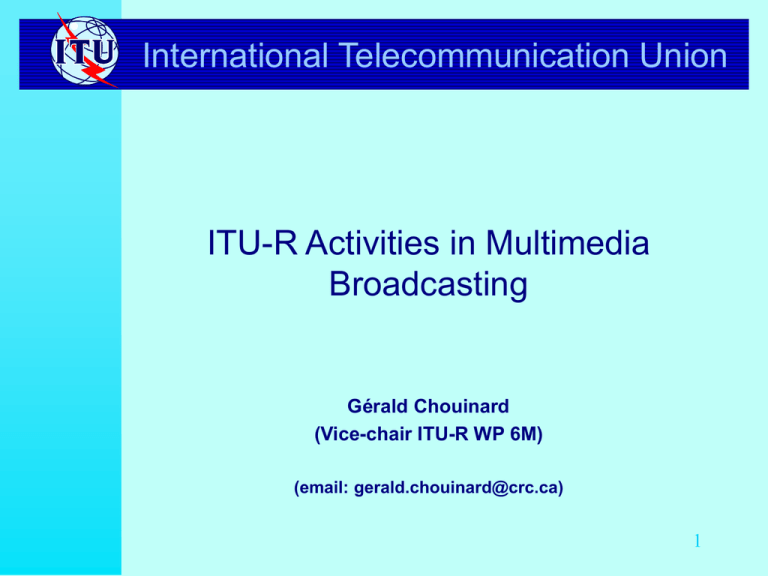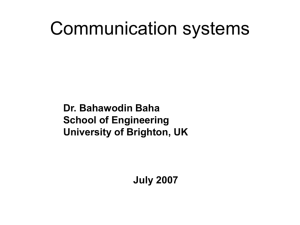International Telecommunication Union ITU-R Activities in Multimedia Broadcasting 1
advertisement

International Telecommunication Union ITU-R Activities in Multimedia Broadcasting Gérald Chouinard (Vice-chair ITU-R WP 6M) (email: gerald.chouinard@crc.ca) 1 ITU-R Study Groups • SG1- Spectrum Management • SG3- Radiowave propagation • SG4- Fixed Satellite Service •• SG6- Broadcasting Services • SG7- Science Services • SG8- Mobile, Radio Determination • (Terrestrial and Satellite) SG9- Fixed Services 2 Study Group 6: Broadcasting • WP6P - Content production / • • •• • • postproduction WP6R – Recording for production, archival and play-out WP6A – Program assembling and formatting WP6M – Interactivity and multimedia WP6E – Terrestrial delivery WP6S – Satellite delivery 3 WP6M – Interactivity and multimedia • Requirements for interactive • • radiocommunication broadcast services and systems Approaches and requirements in multimedia production, coding and multiplexing Interfaces to webcasting including the supporting data services 4 Key activities of WP 6M • WRC 2005: multimedia spectrum requirements – Identify service features for interactive broadcasting – Identify return link capacity requirement for interactive broadcasting – 7 Questions to be answered from WRC 2000 • definition of Multimedia service • Expected spectrum requirement • • – Identify spectrum requirement for multimedia (Joint effort with WP 6E, SG 1, SG 8 and SG 9) Multimedia TV broadcasting (terrestrial/satellite) – Develop worldwide presentation and execution environments for DTV interactive rendition (XML presentation, JAVA execution engine, EPG, local and remote interactivity, content tagging, copy control) Multimedia Mobile Broadcasting terrestrial/satellite) – DAB and return link by PCS (e.g., GSM/GPRS) 5 Attributes of Broadcasting • • • • • Broadcasting: program streaming – real time QoS is very important Broadcasting has been “push technology” and advertisement supported services for many decades Broadcasting has been dealing with multimedia for many decades: sound, video and data Broadcasting is used to IPR management of content (paying royalties) Broadcasting: close to content production, applications and rendition on user terminal 6 7 Questions from WRC’2000 1. 2. 3. 4. What is your understanding of the term "terrestrial wireless interactive multimedia systems" and its scope? What specific characteristics (operational and technical) are considered to make a system suitable for terrestrial wireless interactive multimedia applications? What are the various applications and technologies that may fall under terrestrial wireless interactive multimedia systems? What is the current situation regarding spectrum use by the applications and technologies identified in question 3 above? 7 7 Questions from WRC’2000 (cont’d) 4. 5. 6. What are the sharing scenarios with respect to other uses of the same spectrum? What are, if any, the regulatory impediments to the development of terrestrial wireless interactive multimedia systems? What are the possible trends in this area in the next 510 years and how will they impact on responses to the above questions? 8 Thank you! 9

